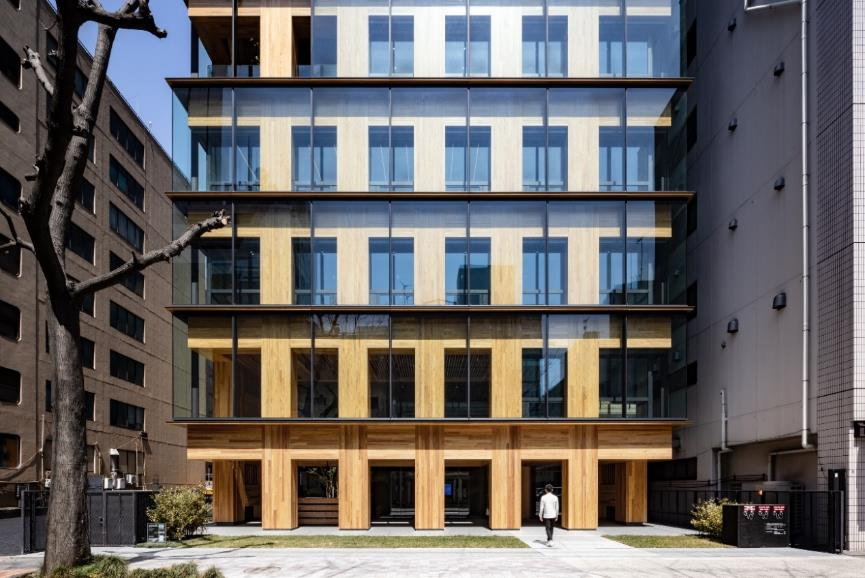
Project Name: Port Plus Obayashi Yokohama Training Center
City: Yokohama
Rating System: LEED v4 BD+C(Hospitality)
Certification Date: August 2022
Certification level: Gold
Interviewee: Mari Ota, Obayashi Corporation
Interviewer: Chiaki Saito, Green Building Japan Steering committee member
Editor: Yasuhiro Imai, Kana Mizutani, Green Building Japan Steering committee member
GBJ interviewed Obayashi’s Port Plus building in Yokohama. It is an iconic building among the wooden structure and LEED certified.
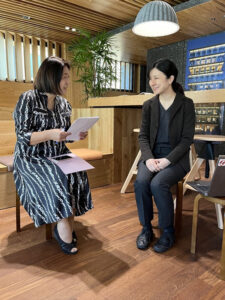
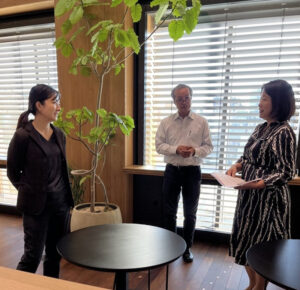
Interview at Port Plus
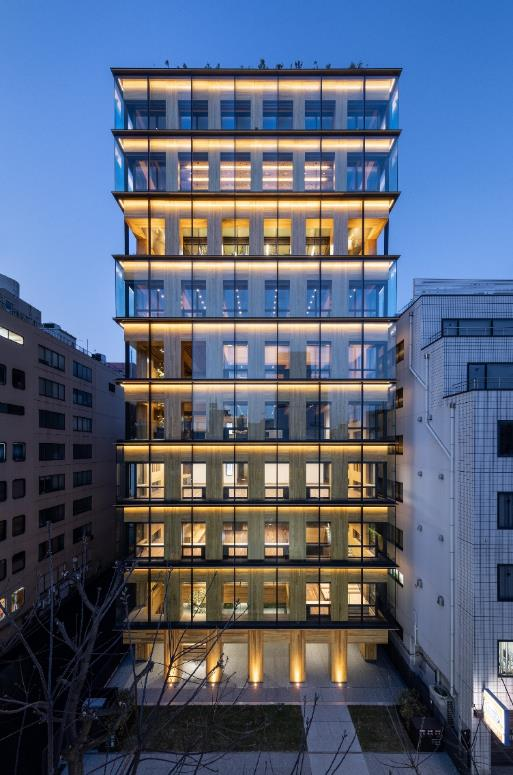
Port Plus Exterior Photo by SS Inc. Naomichi Sode
Green Building Japan Chiaki Saito
The building Port Plus® serves as an employee training center. Could you please elaborate on the activities conducted at the training center? Additionally, we know that Port Plus is garnering attention as Japan’s first fully wooden and fire resistant high rise structure. Could you kindly provide insight into the rationale behind your company’s promotion of wooden architecture?
Mari Ota from Obayashi
Our company has strategically laid out an action plan, employing a backcasting approach toward “Obayashi Sustainability Vision2050” for envisioned state in 2050. As part of this comprehensive framework, one of our key initiatives involves promoting the wooden structures and interiors for large buildings, aligning with our commitment to sustainability for the planet, society, and people. We feel honored to say the Port Plus project represents a bold venture, undertaking the challenge of constructing a high-rise building entirely from wood, leveraging current technology and regulations. The project aims to broaden the horizons of wooden structure, presenting it as a viable option for the industry and all stakeholders involved.
Furthermore, positioned as a next-generation training facility, our aim is to offer a unique space distinct from both home and workplace environments, allowing individuals to step away from their routine tasks and immerse themselves in unique experiences and benefits exclusive to this specialized training center. We focus on four themes: promotion, innovation, wellness, and sustainability.
The design phase for this training center spanned approximately two years, initiating from 2018, followed by a construction period from March 2020 to March 2022. The training center commenced operations in April 2022. After a year and a half since completion, we have engaged in various programs, including equipment testing and commissioning, to conduct observations on performance and comprehensive aspects of the pure wooden structure and the facilities. We have curated a high-quality spatial experience that enhances the promotion and synergy generated by our collective gatherings. We are pleased to note that our efforts have yielded excellent outcomes over the past year.

Photo by SS Inc. Naomichi Sode
Chiaki Saito
Port Plus achieved LEED Gold certification in August 2022. According to the Scorecard, the project received a notable high score of 3 points in the Life Cycle Assessment (LCA) category of the LEED rating system. Given the growing interest in mitigating CO2 emissions across the entire life cycle of a building, encompassing both the operational phase and the production of building materials, such as embodied carbon and whole-life-cycle carbon, the LEED evaluation aligns well with this perspective. We think being able to visualize the LCA has brought about positive effects. Have you had any feedback?
Mari Ota
We have acknowledged that wooden structures have a relatively low environmental impact. Regarding the LCA of the structure and building envelope material (“up front carbon” of the building materials used), which is subject to LCA evaluation at LEED, the evaluation results demonstrated a lower environmental impact, the results demonstrated a lower environmental impact compared with the baseline applying conventional steel frame structure, as anticipated. Port Plus, constructed predominantly from wood, stands as an exemplary illustration of advocating for the reduction of embodied carbon based on LCA study. This aligns with the increasing awareness of embodied carbon.
Chiaki Saito
Wooden buildings are often acclaimed for their superior insulation performance, and it appears that Port Plus showcases excellence in both watertightness and airtightness, substantiated by the attainment of LEED credits, right?
Mari Ota
The thermal insulation attributes of the wooden envelope were apparent from the design phase, surpassing the LEEDv4 energy modeling baseline. To assess airtightness, a comprehensive Blower Door Test, a rarity in Japan, was conducted on the entire building. The test results validated minimal air leakage and had been verified to align with the standards of ASHRAE 90.1 2016, boasting an air leakage rate below 7.2m3/h/m2 @75Pa. Essentially, we verified the Port Plus’s high air tightness through on-site testing, proving that it is not only a building designed with high thermal insulation properties, it is also a highly energy-efficient building.
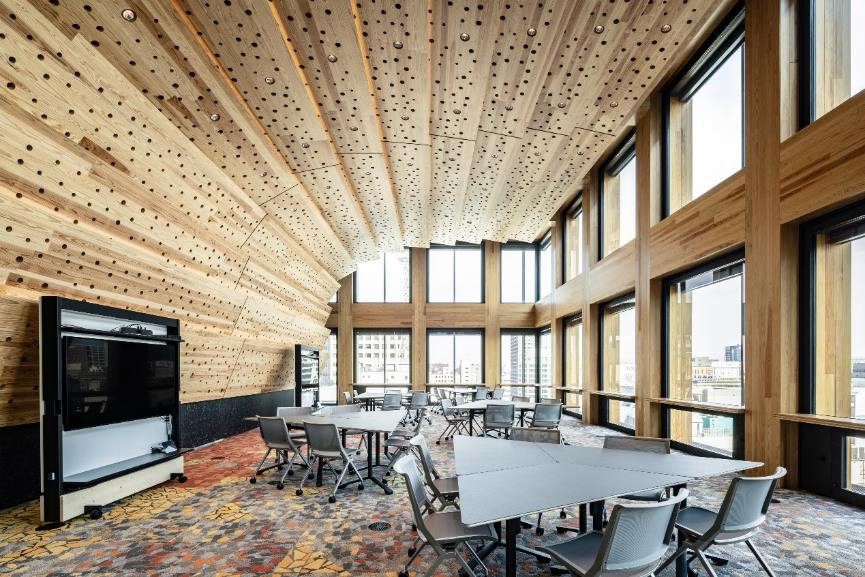
Training room with wooden materials Photo by SS Inc. Naomichi Sode
Chiaki Saito
Upon entering the building, the harmonious interplay of wood texture and daylight is obvious. Could you elaborate on whether daylighting contributed to the attainment of your LEED score?
Mari Ota
Through the strategic use of wooden beams as eaves, our design achieves a balance between softening direct sunlight and allowing abundant natural light into the space. In the LEED Indoor Environmental Quality (IEQ) category for daylight utilization, we earned 1 point by meeting the requirement of calculating the proportion of the regularly occupied spaces with an illuminance measurement exceeding 300 lux, as stipulated by LEED standards. To enhance daily usability, people can manually open/close the blinds and adjust the angle through the wall-mounted control panel. Furthermore, dimming modes based on the season, blind controls at hourly intervals are set, and automated these functions for seamless operation.
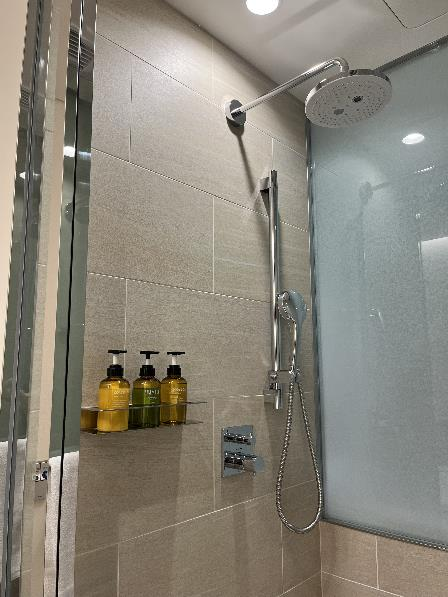
Shower booth in lodging room
Chiaki Saito
Since there are also accommodation facilities in the Port Plus, the daily use of bathing amenities becomes imperative. Implementing water-saving measures, particularly stringent under LEED standards, poses a notable challenge. Could you shed light on the strategies employed in this regard?
Mari Ota
We meticulously considered water-saving appliances, engaging in discussions with the suppliers to align with the U.S. WaterSense standard. Although we did not integrate recycled water sources such as rainwater or wastewater, we successfully achieved a commendable 30% reduction in water usage compared to the baseline, earning 2 points within the LEED rating system. Notably, the facilities in Port Plus include all-gender (single user) toilets, precluding the option to conserve water through the use of men’s urinals. Despite this, users feedback has been notably positive, with no complaints, and actual water usage has proven to be lower than initially anticipated when benchmarked against similar buildings. In light of Japan’s growing concerns regarding water resource uncertainty, our commitment extends to continuous monitoring of water usage within the project.
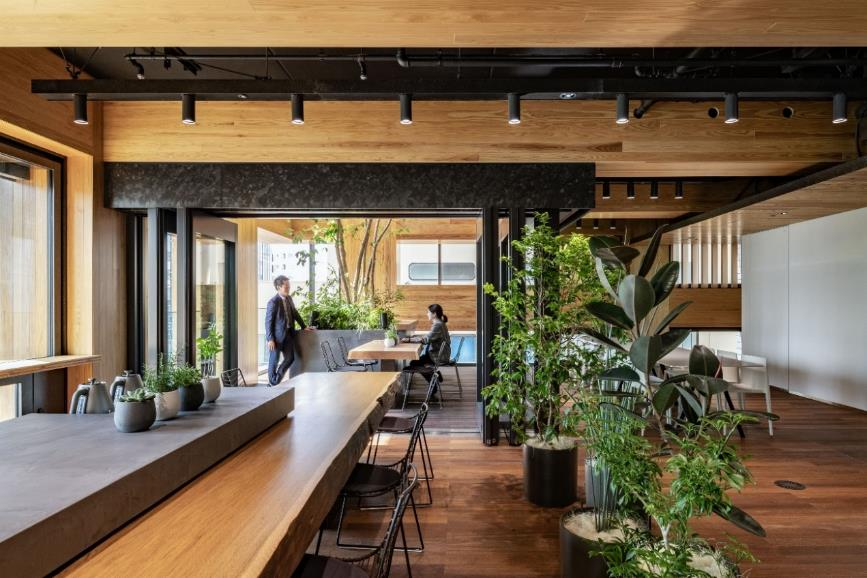
Common space Photo by SS Inc. Naomichi Sode
Chiaki Saito
What inspired the decision for Port Plus to pursue LEED certification?
Mari Ota
We did not originally design Port Plus to meet LEED requirements; rather, our intention was to assess its alignment with globally recognized third-party green building standards. It is genuinely gratifying that Port Plus, with its emphasis on design and facilities, successfully secured LEED Gold certification. Our pursuit is not blindly fixated on achieving the highest certification level. While measures, such as installing an underground storage tank for rainwater reuse, utilizing EPD-certified manufacturers’ products for interior materials, or obtaining renewable energy certificates (RECs), could elevate us to LEED Platinum, but as highlighted earlier, our primary focus remains on the rationality of design concepts and facility configurations.
Although there are relatively fewer LEED credits directly attributable to wooden elements, the overall high evaluation of Port Plus has instilled confidence among stakeholders and significantly contributed to the promotion of wooden building.
Central to the ethos of Port Plus is a commitment to well-being. Consequently, we have also achieved WELL Platinum certification, the highest level, facilitated by the innovation points earned through our LEED certification.
Chiaki Saito
We look forward to the global expansion of Obayashi’s wooden building as the global interest in wooden structure continues to grow. Concurrently, there is a rising trend in buildings attaining both LEED and WELL certifications. Could you share your expectations and proactive strategies for the future development of wooden building, LEED, and WELL?
Mari Ota
The surge in attention towards wooden building on a global scale, particularly in regions like North America, Europe, and Australia, is noteworthy, and we find inspiration in the innovative examples emerging worldwide.
Wooden building is intricately connected to the pursuit of a carbon-neutral and decarbonized society. LEED plays a pivotal role in emissions reduction through energy-saving initiatives, while WELL certification contributes to enhancing people’s happiness and well-being. These two certifications are not mutually exclusive; rather, they are compatible and complementary. Conceptually, akin to assembling individual components to construct a wooden structure, we envision a growing number of buildings achieving both LEED and WELL certifications in the future—This idea occurred to me during our approach to Port Plus, a wooden building.
LEED and WELL have evolved into global universal languages and communication tools, providing a straightforward understanding of a building’s performance and sustainable characteristics. While some requirements align with local green building standards, the majority remain rooted in North American standards, posing a challenge for projects in Japan to accrue comparable points to those in the United States.
To address this, I believe the key challenge in expanding rating systems like LEED in Japan is to enhance the recognition and equivalency of the rating system with Japan’s domestic green building standards. This could be achieved through approaches like the Alternative Compliance Path (ACP). The strategy aims to uphold the international uniformity of LEED while improving its adaptability to local markets.


